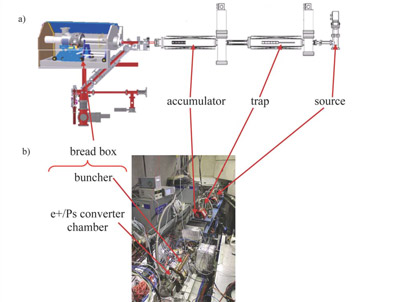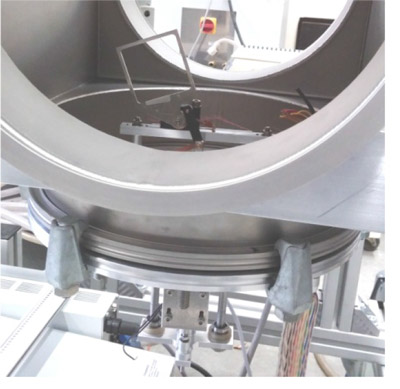AEgIS

AEgIS positronium source
In parallel to the work within ASACUSA, SMI has joined since 2013 the AEgIS (Antimatter Experiment: gravity Interferometry Spectroscopy) collaboration with a team of 6 scientists including 3 post-docs and 1 Master student. One postdoc, hired in June 2013, is working full-time on AEgIS 17 and is responsible for the development of its positron apparatus. In the AEgIS experiment, a Surko-trap is used to store and to bunch the positrons (e+) that will be used for antihydrogen production via the charge exchange reaction p + Ps → H + e-. This system has been assembled and tested in 2012.
Starting from June 2013, SMI has worked on enhancing the performance of the Surko-trap. In particular, cooling gas pressure and rotating wall frequency and amplitude in the Surko-trap have been optimized - increasing the positron lifetime to around 2 minutes. Under optimal conditions more than 4×107 positrons are stored and bunched. In addition to this, a new chamber, which will be used for Positronium formation and laser excitation experiments, has been connected to the positron system. The planned tests aim to investigate cooling and Rydberg excitation of Positronium, which is necessary to maximize antihydrogen production. The chamber has been designed to house a special target for positron/Positronium conversion [1, 2].
Positron bunches are extracted by magnetic field from the Surko-trap and are then transported by electrostatic lenses. To have the possibility to produce Positronium in the absence of magnetic field, magnetic and electric fields are then uncoupled by a mu-metal field terminator. The positron transport and the uncoupling of magnetic and electric fields with this system have been successfully demonstrated during the last months.
The lenses of the buncher are designed to inject the e+ into the positron/Positronium converter with energy between 5 and 9 keV in less than 5 ns, to match the laser pulse used for the excitation. The buncher is currently being tested.
To get sufficient information about Ps formation and excitation, tests have been performed to identify a detector suited for the study of simultaneous annihilations of many positrons (of the order of 107 e+). Several promising candidates with the required time (FWHM of few ns) and saturation characteristics (no saturation in presence of many simultaneous annihilations) have been identified.
The SMI team involved in AEgIS is also working on designing the interface between the AEgIS antihydrogen formation trap and the experimental region as well as the spectrometer line adapted to the AEgIS environment. Significant progress has been made in 2013 on the designs of those parts.
[1] S. Mariazzi, P. Bettotti, S. Larcheri, L. Toniutti, and R. S. Brusa, Phys. Rev. B 81, 235418 (2010)
[2] S. Mariazzi, P. Bettotti, and R. S. Brusa, Phys. Rev. Lett. 104, 243401 (2010)

AEgIS beam line shutter
Electrons and antiprotons in the antihydrogen formation trap will be exposed to thermal radiation from the warmer downstream beam pipe. In order to reduce heating of trapped particles a shutter could be placed in the beam line. It would be opened just before antihydrogen atoms are produced to keep the trap shielded as long as possible. An opening time of several ms is foreseen. Additionally the shutter temperature has to be about 20 K and it must be suited for operation in UHV.
To study the feasibility of such a device a prototype was designed and constructed. Two solenoid magnets are used as actuators to open and close the shutter. The magnets are placed outside the beam pipe vacuum in the Outer Vacuum Chamber (OVC) to reduce the required space and to avoid heat emission when the magnets are operated. A metal rod inside bellows acts as a linear feedthrough from the OVC to the beam pipe UHV where it drives the shutter blade. As the blade is heated by absorption of thermal radiation and through the rod, which connects it to the warmer OVC, it is necessary to actively cool it. This is done via a flexible copper tape that has its ends connected directly to the shutter blade and to a cold head at 10 K.
In preliminary tests cooling power was found to be sufficient to keep the shutter blade at 110 K while the magnets and the surrounding vacuum chamber were at room temperature. The time required to open the cold shutter was determined with a photo barrier. Using a standard lab power supply at 60 V an opening time of 15 ms was reached.

Beam Optics Simulations
Effects of a sextupole magnet in the downstream beam line on the antihydrogen count rate of the gravity and hyperfine spectroscopy (HFS) experiments were investigated using the GEANT4 simulation toolkit. Atoms were assumed to be in ground state and to be with equal probability in a hyperfine state that is either focused or defocused by a sextupole magnet. While a sextupole after the source is mandatory for HFS it was studied whether it could also be beneficial for the gravity experiment. In this case the sextupole might be used in both experiments and may be installed before the interface.
Depending on position and field strength of the sextupole and temperature of the atoms (0.1 K – 20 K) it was found that the count rate can be increased by a factor of up to ten. The Figure (right) shows exemplarily how the gain reaches a maximum for an ideal sextupole field strength. In case of HFS the dependence of the count rate on parameters of the polarizing and analyzing sextupole magnet was examined. For both experiments field strengths of up to 1.3 T
seem to allow a considerable improvement. Hence a permanent magnet is in principle an option.
Additional Information
The research in the field of AEgIS beam line shutter and Beam Optics Simulations is conducted as Master thesis of S. Lehner.